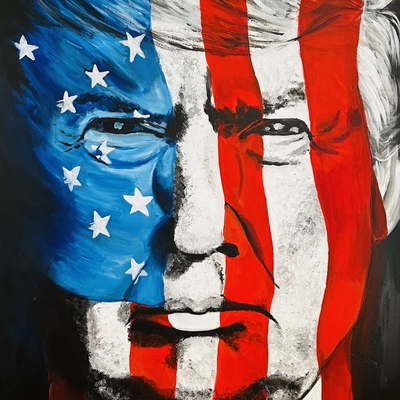Stay informed on the latest Truth Social posts from Donald Trump (@realDonaldTrump) without the doomscrolling. Consider it a public service for your mental health. (Why?)
- The Fed should have raised rates in early 2021.
- The entire Fed organization is broken and needs to be fixed.
- The Fed needs to use modern sources of information.
- There is strong disagreement with Ken Griffin's position on defending theoretical independence.
- Incompetence at the Fed is a more significant issue than defending theoretical independence.
- The Fed's adapted 'two target' approach is too low and rigid.
- The Fed followed data that is years delayed.
- The Fed's disbelief in the importance of money supply is a major problem.
- Chair Powell was late to raise rates.
- Interest rates need to come down.
- Chair Powell is delaying rate cuts.
- The Fed is expected to cut rates by 50, 75, or potentially 100 basis points.
The post directly criticizes the Federal Reserve's past and present monetary policy, specifically calling for significant interest rate cuts (50-100 bps). Such explicit and strong commentary on Fed policy from a prominent political figure can significantly influence market expectations for future rate decisions, investor sentiment, and thus directly impact the S&P 500, leading to a high score.
The post focuses exclusively on domestic monetary policy and the performance of the Federal Reserve. It contains no references to international relations, military actions, or geopolitical threats, leading to a zero score for international conflict escalation likelihood.
- Commodities: Expectations of significant rate cuts typically weaken the US Dollar, which can make dollar-denominated commodities like Gold (XAU) and Oil (WTI) more attractive, potentially leading to price increases. Lower rates could also stimulate economic activity, further supporting industrial metals. Short-Term Watchlist: XAU/USD price action, oil inventory reports, immediate reactions to Fed speakers. Medium-Term Focus: Inflation trends, actual Fed policy shifts, USD trajectory, global growth outlook.
- Currencies (Forex): Calls for substantial interest rate cuts signal a looser monetary policy outlook, which is generally bearish for the US Dollar Index (DXY). This would likely lead to strengthening of major currencies like EUR and JPY against the USD. Short-Term Watchlist: Fed speakers' reactions, Treasury yields, shifts in global risk sentiment. Medium-Term Focus: Divergence in central bank policies (Fed vs. ECB/BoJ), global economic growth differentials, broader dollar liquidity cycles.
- Global Equities: Anticipation of aggressive rate cuts, while potentially signaling economic concerns (as the Fed is 'late' and 'dragging its feet'), is generally viewed as a positive catalyst for equities due to lower borrowing costs and improved valuations. This could lead to upward pressure on major indices like the S&P 500, Nasdaq, STOXX 600, Nikkei 225, and Hang Seng. Short-Term Watchlist: Futures open, VIX levels, performance of rate-sensitive sectors (e.g., technology, housing). Medium-Term Focus: Corporate earnings revisions, macro economic data (ISM, PMI), global capital flows, and the resolution of any geopolitical overhangs.
- Fixed Income (Bonds): Strong calls for rate cuts would typically lead to a rally in bond prices (yields falling), particularly for shorter-duration US Treasuries. The perception of an 'incompetent' Fed might introduce some systemic risk, but the primary driver would be the expected easing of monetary policy. Credit spreads could tighten if the market interprets rate cuts as supportive of corporate health. Short-Term Watchlist: UST 10Y and 2Y yield levels, TED spread, flows into credit ETFs. Medium-Term Focus: Future Fed dot plots, evolving fiscal concerns, debt ceiling rhetoric, and economic surprise indices.
- Volatility / Derivatives: The specific calls for rate cuts could, paradoxically, reduce policy uncertainty in the short term, potentially leading to a compression in the VIX. However, the strong criticism of the Fed as 'broken' and 'incompetent' introduces a new layer of institutional and systemic risk perception, which could provide a floor or even lead to spikes in volatility if interpreted negatively by market participants. Short-Term Watchlist: VIX levels versus VIX futures term structure, 0DTE options flow, SKEW index. Medium-Term Focus: Potential shifts in volatility regimes, uncertainty regarding future macro policy, and systemic tail risks like elections or geopolitical events.
- Crypto / Digital Assets: Bitcoin (BTC) and other digital assets often behave as risk-on assets and are highly sensitive to global liquidity conditions. Expectations of significant rate cuts, implying a looser monetary environment, would likely be seen as a positive catalyst, potentially leading to price increases. Short-Term Watchlist: BTC/USD price action, Coinbase order book activity, funding rates across exchanges, correlation with Ethereum (ETH). Medium-Term Focus: Evolving regulatory news, stablecoin flows, progress on Ethereum upgrades, and the broader macro liquidity backdrop.
- Cross-Asset Correlations and Systemic Risk: If the market interprets the calls for rate cuts as a necessary correction for past Fed 'incompetence' to support the economy, traditional correlations might hold (e.g., equities up, bonds up on lower yields, USD down). However, if the severe criticism of the Fed's 'broken organization' creates a significant lack of confidence in institutional stability, it could lead to breakdowns in normal correlations, such as equities and bonds selling off together. Short-Term Watchlist: MOVE index, performance of junk bond ETFs, co-movement of gold/USD. Medium-Term Focus: Risks within the shadow banking sector, potential for central bank intervention, and signs of stress in market plumbing.
- Retail Sentiment / Market Psychology: Such direct and strong criticism of the Federal Reserve, coupled with explicit predictions for aggressive rate cuts, can significantly influence retail investor sentiment. This could potentially trigger increased speculation in certain asset classes (e.g., growth stocks, cryptocurrencies) as retail traders react to the perceived future policy direction or political pressure on the Fed. Short-Term Watchlist: Trading volume in meme stocks, trends on social media platforms like Twitter/X and Reddit, mentions on TikTok. Medium-Term Focus: The ongoing influence of social media on market structure, potential for coordinated retail trading pushes, and any policy or regulatory responses to retail trading behavior.

